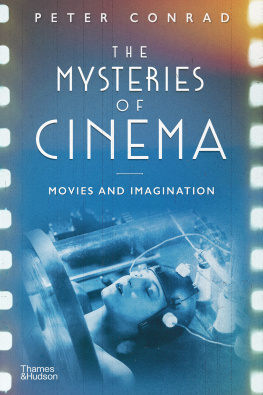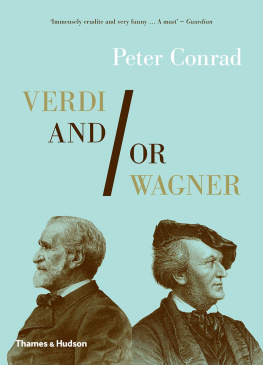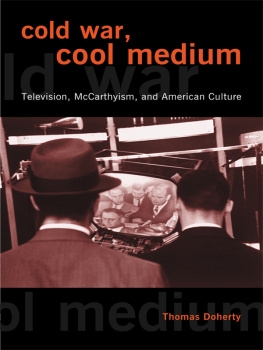ROUTLEDGE LIBRARY EDITIONS: CULTURAL STUDIES
Volume 7
TELEVISION
Television
The medium and its manners
Peter Conrad
First published in 1982 by Routledge & Kegan Paul
This edition first published in 2017
by Routledge
2 Park Square, Milton Park, Abingdon, Oxon OX14 4RN
and by Routledge
711 Third Avenue, New York, NY 10017
Routledge is an imprint of the Taylor & Francis Group, an informa business
1982 Peter Conrad
All rights reserved. No part of this book may be reprinted or reproduced or utilised in any form or by any electronic, mechanical, or other means, now known or hereafter invented, including photocopying and recording, or in any information storage or retrieval system, without permission in writing from the publishers.
Trademark notice : Product or corporate names may be trademarks or registered trademarks, and are used only for identification and explanation without intent to infringe.
British Library Cataloguing in Publication Data
A Catalogue record for this book is available from the British Library
ISBN: 978-1-138-69145-2 (Set)
ISBN: 978-1-315-45997-4 (Set) (ebk)
ISBN: 978-1-138-20741-7 (Volume 7) (hbk)
ISBN: 978-1-138-20823-0 (Volume 7) (pbk)
ISBN: 978-1-315-46237-0 (Volume 7) (ebk)
Publisher's Note
The publisher has gone to great lengths to ensure the quality of this reprint but points out that some imperfections in the original copies may be apparent.
Disclaimer
The publisher has made every effort to trace copyright holders and would welcome correspondence from those they have been unable to trace.
TELEVISION: the medium and its manners
Peter Conrad
First published in 1982
by Routledge & Kegan Paul Ltd
9 Park Street, Boston, Mass. 02108, USA, 39 Store Street, London WCIE 7DD and Broadway House, Newtown Road, Henley-on-Thames, Oxon RG9 IEN Set in II on 13Pt Sabon by Rowland Phototypesetting Ltd, Bury St Edmunds, Suffolk and printed in the USA
Peter Conrad, 1982
No part of this book may be reproduced in any form without permission from the publisher, except for the quotation of brief passages in criticism
ISBN 0-7100-9040-4
ISBN 0-7100-9041-2 (pbk)
Furniture
In the Oxford college to which I belong, a television set has been supplied for the delectation of the brain-weary dons. It's hidden away in a musty chamber, bottling up the fug of defunct cigars, called the smoking room. In a corner of that room, it stands masquerading as a Gothic cocktail cabinet, concealed behind panels of fretted wood which have to be opened out like an altar diptych to disclose the screen. People sometimes scuttle across the quad after dark to watch it, conscious (in their furtiveness) that in doing so they're neglecting their pedagogic chores, and the set they watch is as ashamed as they are. Hence its elaborate decorative lie about itself, its nervous attempt to disappear into the seedy antiquity of the room. When you open the doors of that cumbrous box you expect to find cut-glass decanters collared with silver chains identifying the type of toxic spirit they contain. Instead you happen upon a gaping field of grey plastic which is the empty screen.
Why is the television set our dirty domestic secret? Why are we so apologetic about owning one? The dons of Oxford are not alone in their decorative disavowal of the medium. Often in highbrow households the set will be found snugly lodged in a wall of bookshelves, as if proximity could make an ersatz literary object of it. The vulgarly rich have devised more expensive ways to hide it, and the video magazines illustrate ideal living rooms in which the set plays at being something other than itself, either lurking under a tailored cloth impersonating an end table or cowering inside cabinets with doors which can be pulled down like portcullises to occlude the screen. The most ingenious and costly disappearances are contrived by the New York designer Anthony Lombardo, who banishes the set behind magnesium mirrors in a wall of carved panelling, with cane-covered vents above the mantel for the audio outlets. The skulking telly is enticed out of hiding by activating a remote control, and its image glimmers in the depths of the suddenly transparent looking-glass. Sets in stalled by Lombardo are the perfection of discreet self effacement, for they can be viewed without being seen. He has even absconded a set behind tambour doors in the belly of a white baby grand piano.
In contrast with this swanky snubbing of television, in suburban houses the set is encouraged to perform as furniture, propped on a trolley which can be perambulated into hiding but which, while in the room, serves up the programmes as delicacies: the trolleys recall those which fancy restaurants trundle about, loaded with their display of sweets. Perhaps a vase of flowers is lodged atop the set, to acclimatise it; I have also seen a set hooked and suspended from the ceiling like a potted plant. If company arrives when you're watching, the set will probably be left playing, with the volume muffled. This will justify it as a social amenity, a supplier, like piped music in public places, of automatic conviviality, both an encourage ment to and (during awkward silences) a relief from conversation. Always the set has to be supplied with an alibi, an excuse for its presence in and appropriation of the room. In one household I know, a place of no social pretension, an atlas is left casually lying on the table next to the set. 'Why?' I once asked. 'So we can look up where all those wars are happening that we see on television,' I was told. Thus the set legitimises itself as an educational facility, plugging you into the world outside the house. The shiftiest of all television-owners are those who smuggle their sets into their bedrooms. Out in the living room it at least pretends to be of social use. Propped at the bottom of your bed, it stands exposed as the most consolingly solitary of vices. Andy Warhol has even likened masturbation to watching a made-for-TV movie, as opposed to the self-forgetful enchantments of the big screen and the dark auditorium: you resign yourself sadly to an unsatisfying second best. In the living room, the set is a substitute for conversation; in here by the bed, it's a substitute for- and an approximation to - sleep, its inane, inconstant flickering turning the room into the delusory prison of Plato's cave dweller.
Our shame about television twists into superstitious fear. There's a code of manners for television-viewing, with rules to save us from the consequences of our dangerous and unseemly habit. Leave a light on in the room to protect your eyes from damage by the tube; unplug the set at night, or else it's liable to sizzle, explode and incinerate the house in which it's such an unwelcome tenant. The British Television Annual in the early 195 0s contained worried articles on the domestic havoc the new invention was likely to cause. The set's invasion of the house was a cue for disputes over where to locate it. The Annual recommended compromises and placation: 'the main need is to put the set where viewing will be the most comfort able, avoiding the possibility of half the family being shielded from the fire while the other half is roasted on top of it!' This particular contingency was soon disposed of, once television displaced the hearth. Owners were warned to beware of their fickle, combustible possession, told to earth it and enjoined to 'Never Go Beyond the Named Controls - ... do not poke about inside the television receiver.'













